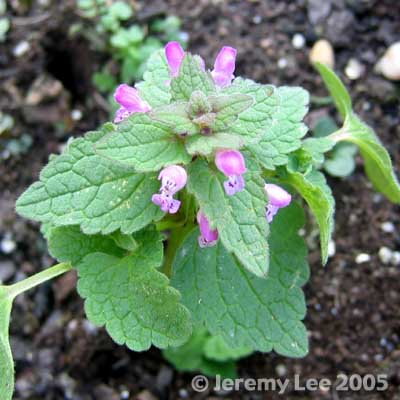
 |
|
Scientific Classifications explained » Amphibians » Ants » Aphids » Bees » Beetles » Birds » Bugs » Butterflies » Caterpillars » Damselflies » Dragonflies » Earwigs » Flies » Frog/Leafhoppers » Fungi » Galls » Grasshoppers » Harvestmen » Hoverflies » Lacewings » Ladybirds » Leaf Mines » Lichens » Mammals » Millipedes » Mosses » Moths » Sawflies » Slugs » Snails » Spiders » Trees » Wasps » Wild Flowers » Woodlice |
UK Nature > Wild Flowers > Red & Pink Wild Flowers > Lamium purpureum

Common Name: Red Dead-nettle Scientific Name: Lamium purpureum Lamium purpureum, more commonly known as Red Dead-nettle, is a member of the Mint family, and this annual plant grows to 20cm in height with an obviously square-looking 4-angled stem. Leaves opposite, stalked, heart-shaped and toothed. Calyx narrowly bell-shaped. Corolla 0.8 - 1.2 cm long, with narrow, straight tube. Lower lip 3-lobed, with thread-like teeth at the sides. Anthers violet, with white hairs. Evidence of red dead-nettle has been found in Bronze Age deposits, and it seems likely that this plant was introduced to Britain with early agriculture. Red dead-nettles are so-called as they do not sting. Flowering season is April to November. Found in waste ground, cultivated land, hedgerows, gardens, rough grassland and on railway and road verges. Common throughout much of the UK, to altitudes of 610 meters. |
|

https://www.uknature.co.uk is a website dedicated to showing the immense diversity of UK nature and wildlife. Our vast range of habitats, from lowland arable to snow covered mountains, from storm-ravaged coastlines to peaceful inland freshwater lakes and rivers, from dry, sandy heaths to deciduous and coniferous forests, all these habitats contribute to the abundance of UK nature. We have wild birds in huge numbers either residing or visiting our shores (597 recorded species as at July 2013) and we must also not forget the humble back garden with its grass lawns, flower beds filled with nectar rich flowers, shrubs and trees, all designed to attract huge numbers of insects such as bees, moths, butterflies and hoverflies; and finally the small ponds which provide safe havens for frogs, toads, newts and even slow worms and grass snakes. www.uknature.co.uk is the showcase for my personal passion, photographing uknature in all its glory. I sincerely hope you all enjoy the fruits of my labours. This site and all images contained therein is © Jeremy Lee 2004 - 2021. All Rights Reserved. Site design by Jeremy Lee. Site development & IT Support by Stuart Lee. |